We’re chugging right along, into week 4 of this project, and alphabetically, we’ve moved on to Angola. Now, along with Mozambique, Angola is probably the most heavily influenced African country by Portuguese colonization many moons ago, and looking through dozens of websites with info on the cuisine, it tends to fall into two categories – either a somewhat traditional West African that seems to be pretty indistinguishable from Nigerian, in fact, they seem to share pretty much the same recipes, or, heavily Portuguese.
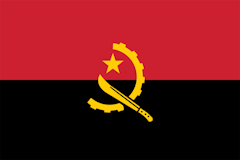 A trio of soups first seemed to be the predominant ones (there are also several stews referred to as soups, but they’re much thicker, and generally served over either rice or the staple manioc (yuca) based polenta-like starch, fungee, so I discarded those). One was a traditional Portuguese caldo verde, or green soup, which is basically a kale or other greens soup; the second was a West African peanut soup, but I decided to save that for Nigeria or Ghana, down the line, where it’s even more prevalent; and the third was a very traditional pumpkin seed soup called egusi, but it uses a specific pumpkin, and several other ingredients that there was just no possibility of my getting my hands on – plus it seemed a bit more like the thicker stews. I was actually set to go with one of the stews and just make it more soup-like when I stumbled on the book Cuisines of Portuguese Encounters, by Cherie Hamilton, which turned out to be a fascinating look at the diffusion of Portuguese cuisine throughout their colonizing history, with local influences in each country. In there, I found a very traditional soup that blends the two traditions admirably, called Mozongué – the national hangover cure. Soup settled.
A trio of soups first seemed to be the predominant ones (there are also several stews referred to as soups, but they’re much thicker, and generally served over either rice or the staple manioc (yuca) based polenta-like starch, fungee, so I discarded those). One was a traditional Portuguese caldo verde, or green soup, which is basically a kale or other greens soup; the second was a West African peanut soup, but I decided to save that for Nigeria or Ghana, down the line, where it’s even more prevalent; and the third was a very traditional pumpkin seed soup called egusi, but it uses a specific pumpkin, and several other ingredients that there was just no possibility of my getting my hands on – plus it seemed a bit more like the thicker stews. I was actually set to go with one of the stews and just make it more soup-like when I stumbled on the book Cuisines of Portuguese Encounters, by Cherie Hamilton, which turned out to be a fascinating look at the diffusion of Portuguese cuisine throughout their colonizing history, with local influences in each country. In there, I found a very traditional soup that blends the two traditions admirably, called Mozongué – the national hangover cure. Soup settled.
Most of the breads were either manioc or corn flour based, and pretty basic, which isn’t what I was going for. Here, I went more towards the Portuguese side of the cuisine, with the very popular in Angola, Rissóis Angolano, basically a type of fried empanada filled with a creamy shrimp mixture. Now, I did deviate here with the combination – the soup, Muzongué, is traditionally served with a manioc flour mixture called pirão, which is basically just 1½ cup flour cooked with 4 cups of fish stock until it’s thick, and then when the soup is served, a big dollop of it is placed in each bowl. I considered that, but also noted there were plenty of versions of muzongué where the pirão was not included, or more often, served on the side, so decided not to go too heavy on the starch there – this is already a pretty rich meal. On to the recipes….
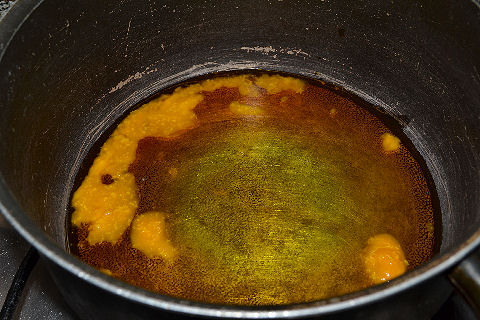 Dende oil – a vivid yellow-orange palm oil that’s traditional to West African cuisine – here it’s available because of the Portuguese influence in Brazil. Roughly a half cup of the oil.
Dende oil – a vivid yellow-orange palm oil that’s traditional to West African cuisine – here it’s available because of the Portuguese influence in Brazil. Roughly a half cup of the oil.
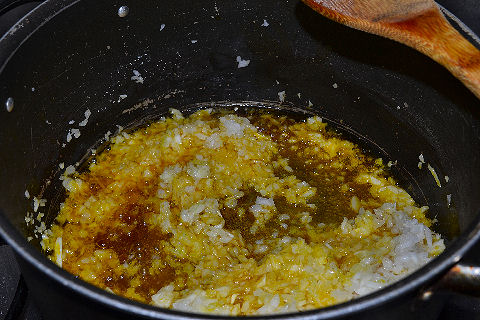 Saute a couple of chopped onions with a teaspoon of salt in the oil until soft.
Saute a couple of chopped onions with a teaspoon of salt in the oil until soft.
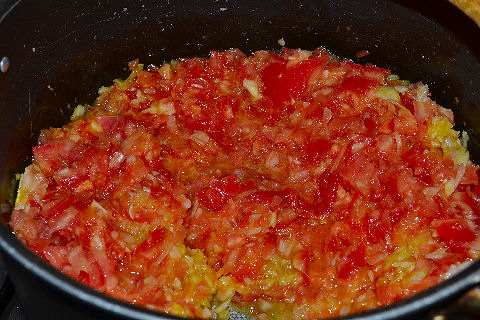 Add three chopped tomatoes and cook down for a couple of minutes.
Add three chopped tomatoes and cook down for a couple of minutes.
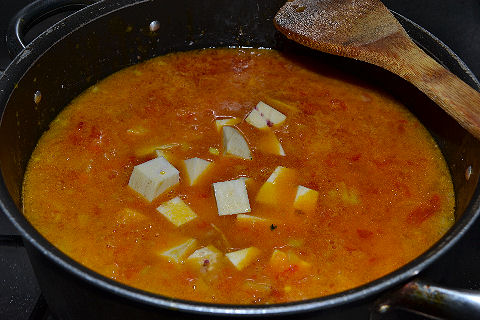 Top with two liters of water, and add in a large, diced sweet potato, and a teaspoon of chopped, tiny, malagueta chilies (again, available here because of Brazil – we only have them pickled, but I figured that would have to do, and because they’re slightly milder pickled, I threw in a few extra). Also add in a kilo of diced white fish of your choice – I used pollack, or abadejo here. Cook until the sweet potatoes are soft. Separately, boil about ¼ kilo (½ pound) of spinach leaves and coarsely chop them. When the soup is ready to serve, add them in just to heat them back up.
Top with two liters of water, and add in a large, diced sweet potato, and a teaspoon of chopped, tiny, malagueta chilies (again, available here because of Brazil – we only have them pickled, but I figured that would have to do, and because they’re slightly milder pickled, I threw in a few extra). Also add in a kilo of diced white fish of your choice – I used pollack, or abadejo here. Cook until the sweet potatoes are soft. Separately, boil about ¼ kilo (½ pound) of spinach leaves and coarsely chop them. When the soup is ready to serve, add them in just to heat them back up.
On to the rissóis…
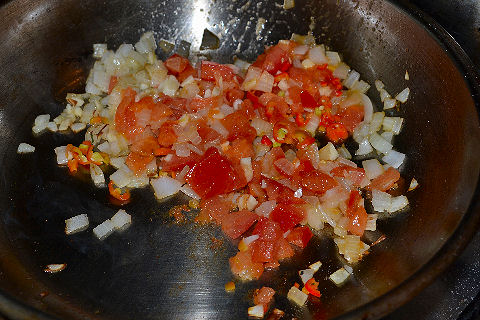 Saute a chopped tomato, an onion, a large clove of garlic, a hot chili, and the zest of half a lemon in a little butter until soft.
Saute a chopped tomato, an onion, a large clove of garlic, a hot chili, and the zest of half a lemon in a little butter until soft.
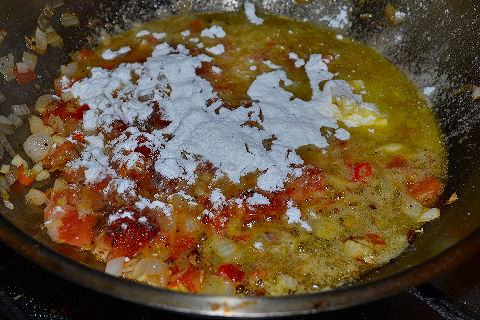 Season with salt, white pepper and nutmeg, and scatter about 2-3 tablespoons of flour over the mixture. Cook for a couple of minutes to get the “raw” flavor out of the flour. (You could also do this in two separate pans – make a bechamel with the butter and flour and the milk and stock below, and separately saute all the other ingredients and then mix them together – but I like the one pan method – it’s also more traditional as best I could tell, albeit less European.)
Season with salt, white pepper and nutmeg, and scatter about 2-3 tablespoons of flour over the mixture. Cook for a couple of minutes to get the “raw” flavor out of the flour. (You could also do this in two separate pans – make a bechamel with the butter and flour and the milk and stock below, and separately saute all the other ingredients and then mix them together – but I like the one pan method – it’s also more traditional as best I could tell, albeit less European.)
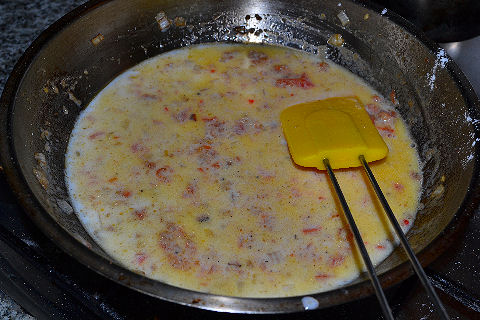 Add ¼ kilo of par-cooked chopped prawns or shrimp and 100 ml each of milk and the water from cooking the prawns, cook until thickened. What I did was boiled up the prawns, then peeled them and returned the shells to the water and let it simmer away for about 15 minutes to extract the flavor.
Add ¼ kilo of par-cooked chopped prawns or shrimp and 100 ml each of milk and the water from cooking the prawns, cook until thickened. What I did was boiled up the prawns, then peeled them and returned the shells to the water and let it simmer away for about 15 minutes to extract the flavor.
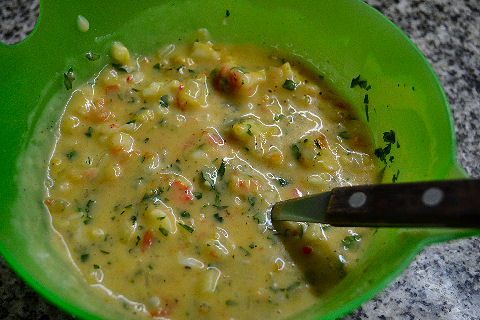 Whisk in an egg yolk and a couple of tablespoons of chopped parsley. Set aside to cool.
Whisk in an egg yolk and a couple of tablespoons of chopped parsley. Set aside to cool.
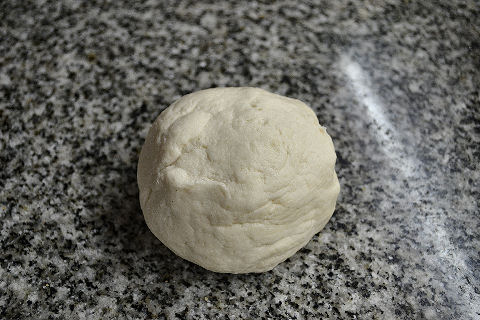 Simple dough – ¾ cup flour, 1¼ teaspoons butter, ? teaspoon salt, and ¼ cup milk. Knead together until smooth, set aside to rest.
Simple dough – ¾ cup flour, 1¼ teaspoons butter, ? teaspoon salt, and ¼ cup milk. Knead together until smooth, set aside to rest.
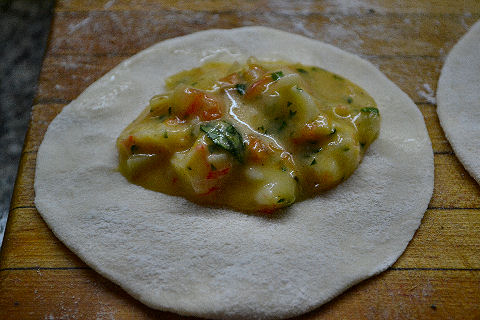 Roll out roughly 7-8cm (3″) rounds and place a heaping tablespoon of the creamy filling on each. Whisk an egg white and use to wet one half of the edge, then fold over and seal well.
Roll out roughly 7-8cm (3″) rounds and place a heaping tablespoon of the creamy filling on each. Whisk an egg white and use to wet one half of the edge, then fold over and seal well.
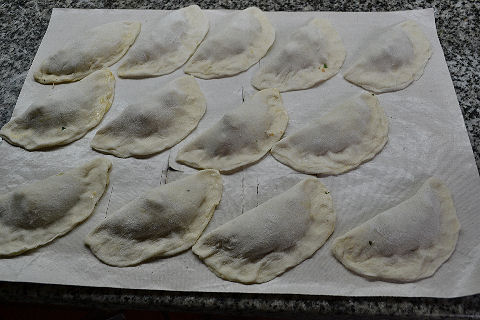 You should end up with around a dozen from this quantity of dough and filling. Whisk together a whole egg, plus the yolk left over from above, dip each of the rissóis in this, let it drain off, and then roll them in breadcrumbs. Fry until golden brown.
You should end up with around a dozen from this quantity of dough and filling. Whisk together a whole egg, plus the yolk left over from above, dip each of the rissóis in this, let it drain off, and then roll them in breadcrumbs. Fry until golden brown.
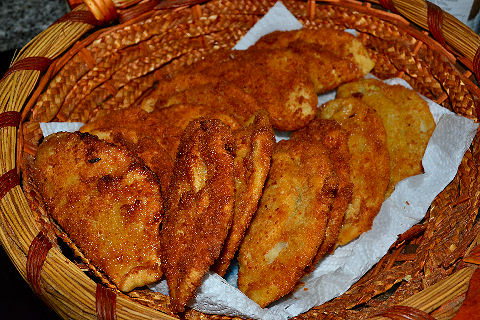 Do those look good or what? I’ll make these again next time we have a party!
Do those look good or what? I’ll make these again next time we have a party!
Anguilla coming up next….
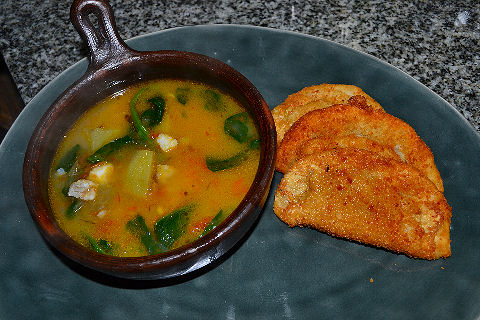
[…] week, Angola. And, by the way, if, as I go along, any of my readers have insights into the upcoming […]